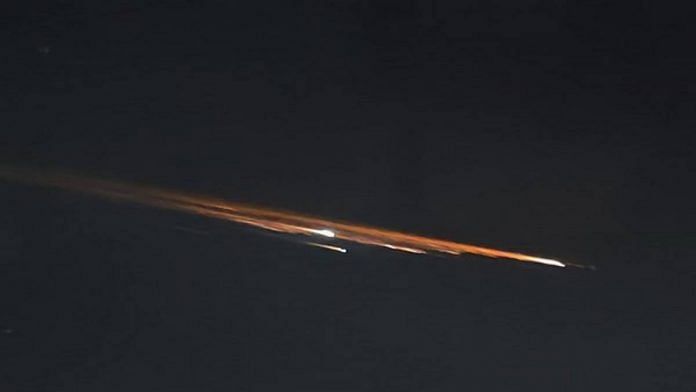Bengaluru: Several videos of the reentry of a discarded Chinese rocket stage from last year into the Earth’s atmosphere were captured over Nagpur — and other parts of Maharashtra, as well as MP — on the evening of 2 April, just after 8pm, local time. The pieces of debris, belonging to a rocket that was launched in February 2021, burned up over the atmosphere, producing fast-moving, bright and fiery streaks in the sky.
At least one bit of debris did not burn up completely and fell over Maharashtra. Such an occurrence is considered relatively rare, as the entry was uncontrolled and large pieces of debris typically fall over the ocean.
The bit of debris, identified as the third stage or the third ejection section, of the Long March or Chang Zheng 3B, was being tracked for almost a week before the reentry, by project SpaceTrack, which keeps tabs on all trackable bits of space debris. However, reentry over the area could not have been prevented as it is a discarded piece of debris without any control.
China has previously had other discarded rocket stages or parts, which have fallen into the Indian Ocean and have even inadvertently collided into the moon. But such occurrences are not uncommon, as all launch carriers around the world design their discarded rocket parts to burn up in the atmosphere and land in the ocean, far away from populated areas.
However, China has come under criticism for being secretive about its space activities and declining to answer questions about such reentry objects, leading to frustration in the space and satellite industry. The capabilities of the communications satellite TJSW-6, which was launched on this rocket in February last year, are currently unclear. The satellite orbits Earth at an altitude of 35,786 kilometres, but the third stage of the rocket ejected much before that, tumbling in space.
Where falling space debris fall
The Long March series of rockets are China’s most powerful, with Long March 3B being the second most powerful rocket in the country. While discarded rocket stages break up easily upon contact with the atmosphere and safely burn up — as expected and designed to do — rockets that are large and heavy can sometimes start orbiting Earth after getting discarded, instead of falling straight through. However, these orbits are not stable and they decay constantly, because of drag from the atmosphere, and the pieces of rocket eventually reenter earth.
There have been many instances of large pieces of spacecraft and rockets falling back to Earth. However, no known incident has resulted in casualties among people living on the ground. Only one person has ever been directly hit by falling space debris, and merely experienced it as a tap on her shoulder.
There are no laws that cover reentry or prevent a nation for allowing a bit of space debris from landing on another’s soil, but space debris damages are held financially accountable due to the 1972 Space Liability Convention. This was previously exercised when Canada asked the former Soviet Union for $6 million in damages in 1978, after radioactive debris was scattered on Canadian soil from a fallen Soviet satellite.
(Edited by Poulomi Banerjee)
Also read: Pluto could be alive with ice volcanoes unlike any seen in solar system, finds New Horizons data



